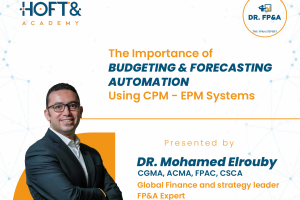
7 Key Insights to Master Driver-Based Planning in FP&A: The Ultimate Guide for Financial Leaders
Dr. FP&A Series | Post #9 🚀
Mastering Driver-Based Planning (DBP) in FP&A
Driver-based planning (DBP) is transforming financial planning by anchoring forecasts to critical business drivers. This method enhances accuracy, agility, and strategic alignment in financial decision-making.
📊 Key insights from this post:
✅ Improve forecast accuracy with data-driven insights.
🔍 Identify core business drivers for better financial planning.
📉 Enhance decision-making through real-world case studies.
⚡ Optimize resources and align strategies with market dynamics.
🔹 Insights by Dr. Mohamed ELRouby ACMA, CGMA, FPAC, CSCA, DBA, OKRP
💡 Explore how companies like Walmart, Pfizer, and BCG leverage DBP for business success.
7 Key Insights to Master Driver-Based Planning in FP&A: The Ultimate Guide for Financial Leaders
Driver-based planning is revolutionizing how financial leaders approach forecasting and strategic decision-making. By focusing on key business drivers rather than traditional financial metrics alone, organizations can create more accurate, agile, and strategically aligned financial plans. This comprehensive guide explores the essential elements of mastering driver-based planning in FP&A.
What is Driver-Based Planning?
Driver-based planning (DBP) is a financial planning approach that links forecasts directly to the critical operational and external factors that drive business performance1. Unlike traditional planning methods that rely heavily on historical financial data, DBP identifies and leverages the cause-and-effect relationships between business activities and financial outcomes4.
This methodology enables finance teams to:
- Create more accurate and reliable forecasts
- Respond more quickly to changing market conditions
- Align financial planning with operational realities
- Enhance strategic decision-making across the organization
The 7 Key Insights to Master Driver-Based Planning
1. Identify Your Critical Business Drivers
The foundation of effective driver-based planning is identifying the specific operational and market factors that truly drive your business performance7. These drivers vary by industry and organization but typically include:
- Operational drivers: Production capacity, employee productivity, customer acquisition costs
- Market drivers: Consumer demand patterns, competitive pricing, market share
- Financial drivers: Working capital requirements, capital expenditure needs, debt service obligations
Successful organizations like Walmart have mastered this by identifying drivers such as store traffic, average transaction value, and inventory turnover as critical metrics that directly impact financial performance9.
2. Build a Robust Data Infrastructure
Effective driver-based planning requires access to clean, reliable, and timely data from across the organization2. This means:
- Implementing integrated systems that connect operational and financial data
- Establishing data governance protocols to ensure data quality
- Creating automated data collection processes to reduce manual effort
- Developing dashboards that provide real-time visibility into key drivers
Organizations must invest in technology solutions that can handle the complexity and volume of data required for sophisticated driver-based models5.
3. Develop Clear Driver-to-Outcome Relationships
The power of driver-based planning comes from understanding how specific drivers influence financial outcomes3. This requires:
- Conducting statistical analysis to validate relationships between drivers and results
- Creating mathematical models that quantify these relationships
- Testing and refining these models based on actual performance
- Documenting assumptions and methodologies for transparency
Financial planners must work closely with operational teams to ensure these relationships accurately reflect business realities8.
4. Focus on Actionable Drivers
Not all business drivers are equally valuable for planning purposes. The most effective driver-based planning focuses on drivers that are7:
- Measurable: Can be quantified and tracked consistently
- Controllable: Can be influenced by management decisions
- Material: Have a significant impact on financial outcomes
- Predictable: Follow patterns that can be reasonably forecast
By concentrating on these actionable drivers, organizations can create plans that not only predict outcomes but also guide management actions9.
5. Implement Rolling Forecasts
Driver-based planning works best when implemented as part of a rolling forecast process that2:
- Updates regularly (typically monthly or quarterly)
- Maintains a consistent forward-looking time horizon
- Adjusts quickly based on changes in key drivers
- Focuses on the most critical business metrics
This approach allows organizations to maintain forecast relevance in rapidly changing business environments while reducing the burden of annual planning cycles4.
6. Integrate Scenario Planning
Driver-based models provide an ideal foundation for scenario planning by allowing teams to6:
- Test the impact of different assumptions about key drivers
- Model best-case, worst-case, and most-likely scenarios
- Identify potential risks and opportunities
- Develop contingency plans for various business conditions
Companies like Pfizer have leveraged this capability to navigate complex market dynamics and regulatory environments with greater confidence10.
7. Align with Strategic Objectives
The ultimate goal of driver-based planning is to support better strategic decision-making8. This requires:
- Ensuring driver selection reflects strategic priorities
- Connecting driver-based forecasts to resource allocation decisions
- Using driver insights to identify strategic opportunities and threats
- Communicating driver relationships to stakeholders throughout the organization
Leading consulting firms like BCG emphasize this strategic alignment as critical to realizing the full value of driver-based planning approaches10.
Implementing Driver-Based Planning: A Practical Approach
Successful implementation of driver-based planning follows a structured approach:
- Start small – Begin with a limited set of key drivers in one business area
- Build cross-functional teams – Include finance, operations, and business leaders
- Invest in technology – Select tools that support modeling and visualization
- Develop skills – Train teams on statistical analysis and driver modeling
- Iterate and improve – Continuously refine models based on actual results
Organizations should expect implementation to be an evolutionary process rather than a one-time event5.
Conclusion
Mastering driver-based planning represents a significant opportunity for FP&A leaders to enhance their strategic value to the organization. By focusing on the key business drivers that truly impact performance, finance teams can develop more accurate forecasts, respond more quickly to changing conditions, and provide better decision support to business leaders.
As demonstrated by leading organizations across industries, the investment in developing driver-based planning capabilities delivers substantial returns through improved resource allocation, more agile decision-making, and stronger alignment between financial plans and business strategy910.



